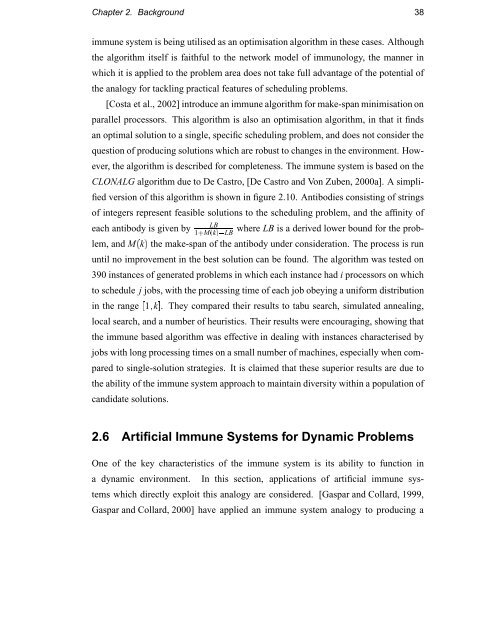Immunology as a Metaphor for Computational ... - Napier University
Immunology as a Metaphor for Computational ... - Napier University
Immunology as a Metaphor for Computational ... - Napier University
Create successful ePaper yourself
Turn your PDF publications into a flip-book with our unique Google optimized e-Paper software.
Chapter 2. Background 38immune system is being utilised <strong>as</strong> an optimisation algorithm in these c<strong>as</strong>es. Althoughthe algorithm itself is faithful to the network model of immunology, the manner inwhich it is applied to the problem area does not take full advantage of the potential ofthe analogy <strong>for</strong> tackling practical features of scheduling problems.[Costa et al., 2002] introduce an immune algorithm <strong>for</strong> make-span minimisation onparallel processors. This algorithm is also an optimisation algorithm, in that it findsan optimal solution to a single, specific scheduling problem, and does not consider thequestion of producing solutions which are robust to changes in the environment. However,the algorithm is described <strong>for</strong> completeness. The immune system is b<strong>as</strong>ed on theCLONALG algorithm due to De C<strong>as</strong>tro, [De C<strong>as</strong>tro and Von Zuben, 2000a]. A simplifiedversion of this algorithm is shown in figure 2.10. Antibodies consisting of stringsof integers represent fe<strong>as</strong>ible solutions to the scheduling problem, and the affinity ofLBeach antibody is given 1 M k byLBwhere LB is a derived lower bound <strong>for</strong> the problem,and M k¥ the make-span of the antibody under consideration. The process is run£until no improvement in the best solution can be found. The algorithm w<strong>as</strong> tested on390 instances of generated problems in which each instance had i processors on whichto schedule j jobs, with the processing time of each job obeying a uni<strong>for</strong>m distributionin the 1¤ k range . They compared their results to tabu search, simulated annealing,local search, and a number of heuristics. Their results were encouraging, showing thatthe immune b<strong>as</strong>ed algorithm w<strong>as</strong> effective in dealing with instances characterised byjobs with long processing times on a small number of machines, especially when comparedto single-solution strategies. It is claimed that these superior results are due tothe ability of the immune system approach to maintain diversity within a population ofcandidate solutions.2.6 Artificial Immune Systems <strong>for</strong> Dynamic ProblemsOne of the key characteristics of the immune system is its ability to function ina dynamic environment. In this section, applications of artificial immune systemswhich directly exploit this analogy are considered. [G<strong>as</strong>par and Collard, 1999,G<strong>as</strong>par and Collard, 2000] have applied an immune system analogy to producing a









![Unit 5. Switches and VLANs [PDF]](https://img.yumpu.com/34422504/1/184x260/unit-5-switches-and-vlans-pdf.jpg?quality=85)






